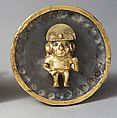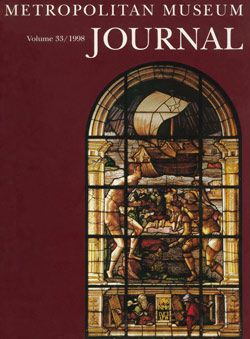Earflare, Warrior
Not on view
At the center of this circular earflare is a high-status warrior. The nearly three-dimensional gold figure at 4.9 cm tall stands out sharply from the tarnished silver of the disk. The eyes were inlaid with a blue-green stone, and the warrior wears a shirt, loincloth, earflares, and a crescent-shaped headdress, the lower section of which takes the shape of an owl with extended wings and a head in high relief. The warrior’s proper right arm bends slightly and the proper left arm is bent at the elbow, suggesting the warrior originally held a war club. This earflare is one of a pair, and its mate (1979.206.1241), which also features a warrior, retains its war club—made of silver sheet—as well as a necklace of blue and green stone, both now missing from this example. War clubs are prominent in Moche representations of battles and ceremonies, but they also appear to have served as generalized symbols of power; on occasion ceramic representations of war clubs adorned the rooflines of buildings.
The Moche flourished between A.D. 200–850 on Peru’s north coast and are well known for their accomplishments in the visual arts, particularly vividly painted murals and reliefs on monumental architecture, ceramics, and metal objects. Elite warriors are an especially prominent subject in Moche iconography. They are shown engaged in combat, taking prisoners, hunting, and participating in ceremonial activities. Archaeological research in the past thirty years has revealed that high-status individuals in the Moche culture were laid to rest wearing the same warrior regalia as those figures depicted on monuments, ceramics, and metal ornaments. It is likely that this pair of earflares was worn by an elite Moche individual and interred in his or her tomb. While ear ornaments have generally been associated with men, recent discoveries at the site of Chornancap suggest that at least in later periods high status women also wore them (Wester La Torre 2012).
This pair of earflares has been associated stylistically with Loma Negra, an archaeological site located in the Upper Piura Valley on Peru’s far north coast. Loma Negra is known for its innovative metalworking artisans who used innovative metalworking methods to create elaborate regalia for elites, legitimizing their authority. The warrior figure was created by joining individually shaped pieces of gold and silver sheet metal through a combination of mechanical and metallurgical methods. The figure was mechanically attached via four tabs (two on each side) inserted into the silver backplate. Twenty-eight stamped semi-circular depressions around the circumference of the disk originally held inlays, probably of greenstone. The rim, the backside of the earflare, and the cylinder shaft, all made of gold sheet, were attached using solder. The rim of the frontal are gold strip and sheet, and the stem of the ear ornament—the part that extends through the wearer’s lobe—was attached to the back mechanically with three tabs.
The visual juxtaposition of silver and gold was highly symbolic for the Moche. The joining of these two metals is one of the signature features of Moche metalworking, and it had cosmological and political significance. Sixteenth-century sources reveal that gold was associated with the sun, and silver with the moon in the Pre-Columbian world. At the Moche site of Sipán, excavations by Walter Alva revealed a striking pattern of complementarity among the gold and silver objects in Tomb 1: ceremonial knives, backflaps (an element of warrior regalia), and ingots were made in pairs, one of gold and one of silver. The gold objects were placed on the right side of the deceased, the silver objects on the left. The use of both silver and gold sheet metal to create this ear flare emphasizes the complimentary symbolism of Moche cosmology and highlights the importance of its visual representation in Moche ritual attire.
Alicia Boswell, Culture of Conservation Fellow, 2016–2018
Exhibited
Rain from the Moon: Silver from Ancient Peru, November 3, 2000–April 22, 2001. The Metropolitan Museum of Art, New York.
Loma Negra, a Peruvian Lord's Tomb, October 13, 1992-July 4, 1993. The Metropolitan Museum of Art, New York.
References and Further Reading
Alva, Walter and Christopher Donnan. Royal Tombs of Sipán. Los Angeles: Fowler Museum of Cultural History, University of California, 1993.
Bourget, Steve and Kimberly Jones, eds. The Art and Archaeology of the Moche: An Ancient Andean Society of the Peruvian North Coast. Austin: University of Texas, 2008.
King, Heidi. Rain of the Moon. Silver in Ancient Peru. New York: The Metropolitan Museum of Art, Yale University Press, 2000. [Listed on p. 59, Checklist no. 7]. Pillsbury, Joanne, Timothy F. Potts, Kim Richter, eds., Golden Kingdoms: Luxury Arts in the Ancient Americas. Los Angeles: The J. Paul Getty Museum, 2017.
Schorsch, Deborah, “Silver-and-gold Moche Artifacts from Loma Negra, Peru.” The Metropolitan Museum of Art Journal 33:109-36.
Schorsch, Deborah, Ellen G. Howe and Mark T. Wypyski. “Silvered and Gilded Copper Metalwork from Loma Negra: Manufacture and Aesthetics.” Boletín Museo del Oro 41(1996): 145-163.
Jones, Julie. “Mochica Works of Art in Metal: A Review.” In Pre-Columbian Metallurgy of South America, Elizabeth P. Benson, ed., 53-104. Washington DC: Dumbarton Oaks, 1979.
Wester La Torre, Carlos. Chornancap: Palacio de una gobernante y sacerdotisa de la cultura Lambayeque. Lambayeque, Peru: Ministerio de Cultura del Perú, 2016.
Due to rights restrictions, this image cannot be enlarged, viewed at full screen, or downloaded.
This artwork is meant to be viewed from right to left. Scroll left to view more.




